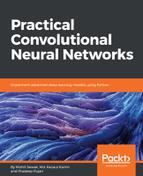When using a CNN, since one of the objective functions is to minimize the evaluated cost, we must define an optimizer. Using the most common optimizer , such as SGD, the learning rates must scale with 1/T to get convergence, where T is the number of iterations. Adam or RMSProp try to overcome this limitation automatically by adjusting the step size so that the step is on the same scale as the gradients. In addition, in the previous example, we have used Adam optimizer, which performs well in most cases.
Nevertheless, if you are training a neural network but computing the gradients is mandatory, using the RMSPropOptimizer function (which implements the RMSProp algorithm) is a better idea since it would be the faster way of learning in a mini-batch setting. Researchers also recommend using the momentum optimizer, while training a deep CNN or DNN. Technically, RMSPropOptimizer is an advanced form of gradient descent that divides the learning rate by an exponentially decaying average of squared gradients. The suggested setting value of the decay parameter is 0.9, while a good default value for the learning rate is 0.001. For example, in TensorFlow, tf.train.RMSPropOptimizer() helps us to use this with ease:
optimizer = tf.train.RMSPropOptimizer(0.001, 0.9).minimize(cost_op)
